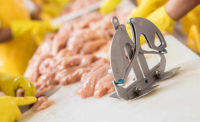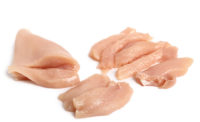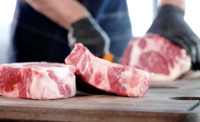Processing Tech
Tight labor market pushes processors toward automation of trimming and deboning operations
Not in the 'manual'

Fixed automation is the most common type of automation used in trimming and deboning. For example, West Liberty Foods (WLF), in West Liberty, Iowa, uses automation for back half processing, such as back, thigh and drum separation and thigh deboning. For WLF, the biggest advantage for automated processing is the reduction in labor required to debone the whole chickens without giblets (WOGs). Associated with this is a reduction in health claims due to a lower overall workforce, says Joe Swanson, vice president of operations.
“Front-half WOG deboning continues to advance with improvements in the yield attained versus the hand deboning process,” he says. “As this gap closes, the automated process will surpass the manual process.”
For turkey deboning, the primary challenge is the variability in WOG size within an individual flock. “For WLF, an additional challenge is fitting an automated process within an existing facility and the disruption to the harvest schedule a change would bring,” Swanson says.
Still, Swanson believes that the tough labor market conditions will drive harvest companies toward automation, even at the expense of a portion of current yield.
“Good advancements are being made on the deboning portion of our process,” he says. “I believe improvement in high-speed vision technology will aid turkey deboning and make inroads on the evisceration process.”
Robotic cutting and deboning
Advancements are occurring in automation and robotics in this processing area. The difference between fixed automation and robotics is fixed automation uses mechanical components that cannot be adjusted much while robotics allows for flexibility. For example, a processor’s fixed automation system might be able to accommodate small, medium and large birds. At the beginning of a shift, though, a processor might need to sort the birds into different sizes and run the birds through on a particular setting that was adjusted manually to be able to handle the size.
“The machines that are out there right now by these big equipment manufacturers can’t treat each bird as being unique,” explains Ai-Ping Hu, a principal research engineer at Georgia Tech Research Institute (GTRI), Atlanta. “They’re using fixed automation solutions. That’s really different from how we’re treating the problem in that we’re using a robotic system that basically can replicate what a human arm can do. Our robots look like human arms with a knife on the end of it.”
GTRI’s robotic systems use machine vision to replicate how people would debone birds and use force sensors to see how hard to press the knife. Combining that information, GTRI’s intelligent cutting systems are able to develop a unique knife path for the robot to follow and get the most meat from each unique carcass.
“We have cases where processors will get the fixed automation machines inside their plant, and they’ll run them for a few years,” Hu says. “Then what ends up happening is because they’re so limited on how much they can adjust to the unique carcass, they end up leaving a high yield on the carcass. They end up taking these machines out and putting people back in because people can get more yield from that carcass.”
Currently, GTRI is working with chicken carcasses, but its robotic systems could apply to any carcasses with a software change.
While people are still the best at performing cutting and deboning skills currently, in terms of being flexible enough to make the different types of operations that need to be done to perform the task, Wayne Daley, a principal research engineer at GTRI, says the issue is getting workers to perform the task for eight hours at a very efficient level.
“We definitely see that we need to figure out a way to reduce the burden on these folks,” he explains. “What has happened is we think now with a combination of different sensing technology and computing power, we think we are close to be able to get something there to help people to do a better job with what they are doing.”
GTRI’s first robotic prototype was much slower than the human speed of deboning about 40 birds a minute. The research group currently is working on a new version that will be comparable to human speed.
Still, Daley is not sure that machines are going to be able to perform all tasks in the cutting and deboning process.
“The anticipated solution is going to be a combination of machines and people,” he explains. “There is this whole area called collaborative robotics where you look at how you design the robots to work with people. You have both people supporting the robots and robots helping the people and how best to implement those types of systems. People are thinking about how best to do that.”
While yield and labor issues will still be concerns for processors in the near future, the good news is with how ubiquitous robotics and visions systems are becoming, costs are coming down for the technology. GTRI calculates costs for investing in robotic solutions for deboning chickens can be regained in a year or two, if not sooner. NP
Looking for a reprint of this article?
From high-res PDFs to custom plaques, order your copy today!







